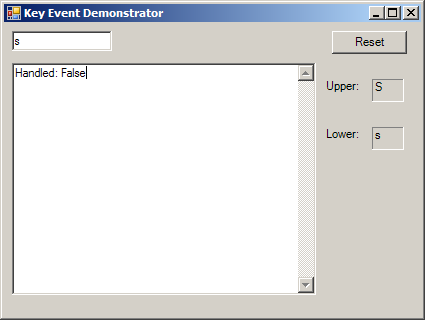
Imports System.Windows.Forms
public class KeyEventSummary
public Shared Sub Main
Application.Run(New Form1)
End Sub
End class
Public Class Form1
Inherits System.Windows.Forms.Form
#Region " Windows Form Designer generated code "
Public Sub New()
MyBase.New()
'This call is required by the Windows Form Designer.
InitializeComponent()
'Add any initialization after the InitializeComponent() call
End Sub
'Form overrides dispose to clean up the component list.
Protected Overloads Overrides Sub Dispose(ByVal disposing As Boolean)
If disposing Then
If Not (components Is Nothing) Then
components.Dispose()
End If
End If
MyBase.Dispose(disposing)
End Sub
'Required by the Windows Form Designer
Private components As System.ComponentModel.IContainer
'NOTE: The following procedure is required by the Windows Form Designer
'It can be modified using the Windows Form Designer.
'Do not modify it using the code editor.
Friend WithEvents txtInput As System.Windows.Forms.TextBox
Friend WithEvents txtMsg As System.Windows.Forms.TextBox
Friend WithEvents btnReset As System.Windows.Forms.Button
Friend WithEvents Label1 As System.Windows.Forms.Label
Friend WithEvents Label2 As System.Windows.Forms.Label
Friend WithEvents lblUpper As System.Windows.Forms.Label
Friend WithEvents lblLower As System.Windows.Forms.Label
<System.Diagnostics.DebuggerStepThrough()> Private Sub InitializeComponent()
Me.txtInput = New System.Windows.Forms.TextBox()
Me.txtMsg = New System.Windows.Forms.TextBox()
Me.btnReset = New System.Windows.Forms.Button()
Me.Label1 = New System.Windows.Forms.Label()
Me.Label2 = New System.Windows.Forms.Label()
Me.lblUpper = New System.Windows.Forms.Label()
Me.lblLower = New System.Windows.Forms.Label()
Me.SuspendLayout()
'
'txtInput
'
Me.txtInput.Location = New System.Drawing.Point(8, 8)
Me.txtInput.Name = "txtInput"
Me.txtInput.TabIndex = 0
Me.txtInput.Text = ""
'
'txtMsg
'
Me.txtMsg.Location = New System.Drawing.Point(8, 40)
Me.txtMsg.Multiline = True
Me.txtMsg.Name = "txtMsg"
Me.txtMsg.ScrollBars = System.Windows.Forms.ScrollBars.Vertical
Me.txtMsg.Size = New System.Drawing.Size(304, 232)
Me.txtMsg.TabIndex = 1
Me.txtMsg.TabStop = False
Me.txtMsg.Text = ""
'
'btnReset
'
Me.btnReset.Location = New System.Drawing.Point(328, 8)
Me.btnReset.Name = "btnReset"
Me.btnReset.TabIndex = 2
Me.btnReset.Text = "Reset"
'
'Label1
'
Me.Label1.Location = New System.Drawing.Point(320, 56)
Me.Label1.Name = "Label1"
Me.Label1.Size = New System.Drawing.Size(40, 16)
Me.Label1.TabIndex = 3
Me.Label1.Text = "Upper:"
'
'Label2
'
Me.Label2.Location = New System.Drawing.Point(320, 104)
Me.Label2.Name = "Label2"
Me.Label2.Size = New System.Drawing.Size(40, 16)
Me.Label2.TabIndex = 4
Me.Label2.Text = "Lower:"
'
'lblUpper
'
Me.lblUpper.BorderStyle = System.Windows.Forms.BorderStyle.Fixed3D
Me.lblUpper.Location = New System.Drawing.Point(368, 56)
Me.lblUpper.Name = "lblUpper"
Me.lblUpper.Size = New System.Drawing.Size(32, 23)
Me.lblUpper.TabIndex = 5
'
'lblLower
'
Me.lblLower.BorderStyle = System.Windows.Forms.BorderStyle.Fixed3D
Me.lblLower.Location = New System.Drawing.Point(368, 104)
Me.lblLower.Name = "lblLower"
Me.lblLower.Size = New System.Drawing.Size(32, 23)
Me.lblLower.TabIndex = 6
'
'Form1
'
Me.AutoScaleBaseSize = New System.Drawing.Size(5, 13)
Me.ClientSize = New System.Drawing.Size(417, 293)
Me.Controls.AddRange(New System.Windows.Forms.Control() {Me.lblLower, Me.lblUpper, Me.Label2, Me.Label1, Me.btnReset, Me.txtMsg, Me.txtInput})
Me.Name = "Form1"
Me.Text = "Key Event Demonstrator"
Me.ResumeLayout(False)
End Sub
#End Region
Private Sub btnReset_Click(ByVal sender As System.Object, ByVal e As System.EventArgs) Handles btnReset.Click
txtMsg.Text = ""
txtInput.Text = ""
lblUpper.Text = ""
lblLower.Text = ""
End Sub
Private Sub txtInput_KeyPress(ByVal sender As Object, ByVal e As System.Windows.Forms.KeyPressEventArgs) Handles txtInput.KeyPress
Dim keyChar As Char
keyChar = e.KeyChar
Console.WriteLine("KeyPress event.")
Console.WriteLine("KeyChar: " + keyChar)
Console.WriteLine("KeyChar Code: " + AscW(keyChar).ToString())
txtMsg.AppendText("Handled: " + e.Handled.ToString())
' Fill in the Upper and Lower labels
lblUpper.Text = keyChar.ToString().ToUpper()
lblLower.Text = keyChar.ToString().ToLower()
' Change $ to #
If (keyChar.ToString() = "$") Then
txtInput.AppendText("#")
e.Handled = True
End If
End Sub
Private Sub KeyMsgBox(ByVal str As String, ByVal e As KeyEventArgs)
Console.WriteLine(str + " event.")
Console.WriteLine("KeyCode name: " + e.KeyCode.ToString())
Console.WriteLine("KeyCode key code: " + CInt(e.KeyCode).ToString())
Console.WriteLine("KeyData name: " + e.KeyData.ToString())
Console.WriteLine("KeyData key code: " + CInt(e.KeyData).ToString())
Console.WriteLine("KeyValue: " + e.KeyValue.ToString() )
Console.WriteLine("Handled: " + e.Handled.ToString())
End Sub
Private Sub txtInput_KeyDown(ByVal sender As Object, ByVal e As System.Windows.Forms.KeyEventArgs) Handles txtInput.KeyDown
KeyMsgBox("KeyDown", e)
End Sub
Private Sub txtInput_KeyUp(ByVal sender As Object, ByVal e As System.Windows.Forms.KeyEventArgs) Handles txtInput.KeyUp
KeyMsgBox("KeyUp", e)
End Sub
End Class